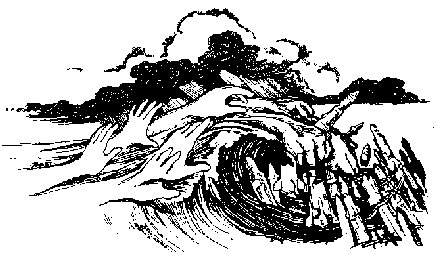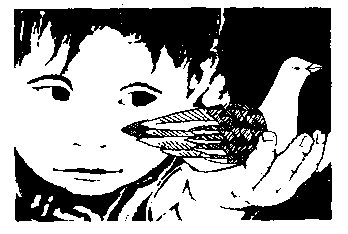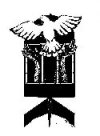

|
| Vieques Resistance Undaunted |
With more than one hundred of their companeros behind bars, supporters
of the struggle to liberate Vieques from the U.S. Navy rallied July 23
in front of the federal prison in Guaynabo, Puerto Rico. They demanded
court dates for the men and women imprisoned there, most for nearly three
weeks by then. Most of those who were locked up are members of the Puerto
Rican Independence Party, who refuse to recognize the U.S. court's jurisdiction
and who, except for a few cases of personal hardship, would not post bond.
A few young Vieques Horsemen for Peace and activist Alberto "Tito
Kayak" de Jesus also refused to post bond, and were being held pending
trial as well.

Two groups did appear before separate judges that day, resulting in 24 people sentenced to time served, and 12 of them also fined $1,000. Over the next three weeks, more small groups were brought to court, where most were sentenced to time served, varying from 3-4 weeks, and some also fined.
On August 3, the Navy began a new round of bombing practice. That evening, writes Robert Rabin of the Committee for the Rescue and Development of Vieques (CRDV), "more than 200 people participated in a People´s Assembly at Peace and Justice Camp, in front of the entrance to the bombing range of Camp García. A resolution was approved by the assembly, reaffirming the commitment of the community organizations to use peaceful civil disobedience in the struggle for peace on Vieques. [Later], around 125 people crossed the street, walked up the the Navy´s fence - heavily fortified with several rolls of razor wire creating a concentration camp atmosphere - to tie ribbons on the fence, sing hymns and chants and reflect while Norma Torres recited her most recent poem, The Silent Fence..."
This "creative tension" induced in a community by the power
of deeply-rooted nonviolent direct action is a stark presence in the daily
life on la isla nena. Reinforcement of the boundary fence separating the
people from their island at the bombing range requires many truckloads
of construction material through the civilian sector. The vehicles are
escorted at high speeds by Puerto Rican police, and the careening trucks
have caused several collisions and property damage, often to the base gate!
Consequently, military convoys are tracked and sailors venturing off base
into the towns are sometimes heckled to get out of Vieques.
Taking a hyperbolic public relations offensive, Navy Lt. Jeff Gordon claimed "militants" had thrown rocks at sailors on the bombing range in recent days, and declared with no regard for the evidence, "This is not a grassroots movement. This is a band of thugs."
Appearing in federal court August 4th, four officials of the Independence Party were jailed for nonpayment of $1000 fines for trespass on Vieques. Puerto Rican Senator Manuel Rodriguez Orellana, Representative Victor Garcia San Inocencio, Rev. Luis Acevedo and mayoral candidate Jaime Negron spent six weeks in jail until their release on September 14. While scores of other resisters have also not paid fines, or have not reported to probation officers, or have publicly defied orders to stay off Vieques while on probation, they have not been contacted by the federal court.
On Sunday, August 6, 5,000 Puerto Ricans, including some barred from returning to Vieques by conditions of their sentence or pretrial release, demonstrated at Ft. Buchanan in suburban San Juan. That night 32 women, led by 11 Vieques residents, quietly slipped onto the bombing range. As dawn broke on Monday, the women held a ceremony and briefly reclaimed the land. The flags of Puerto Rico and Vieques were unfurled, along with a white flag for peace. The women were arrested for trespass and released that day.
| National and International Solidarity with Vieques
In late July, 3 representatives of the Vieques struggle visited South Korea and Okinawa, where U.S. fighter aircraft also bomb and strafe next door to communities organized in resistance. They joined 27,000 people encircling Kadena Air Force Base on Okinawa, and expressed solidarity with the residents of Maehyang-ri village, 50 miles south of Seoul. The Koon-yi bombing range, only a mile from Maehyang-ri village homes, is used five days per week, 15 hours per day, and has been for most of the last 50 years. As in Vieques, periods of popular local resistance have punctuated the decades. Yet today, A-10s, F-16s and other warplanes still bomb and sometimes miss their marks, blasting an elderly woman's garage just last May. As confirmed in Vieques and Okinawa, depleted uranium ordnance is alleged to be fired on the range. Rising cancer rates, miscarriages, birth defects and learning disabilities have contributed to the outrage that is now nation-wide, and recently brought thousands of Korean students, farmers and workers to protest alongside village residents. Five hundred people occupied the bombing range during the large demonstration on June 17. Several demonstrators were arrested and jailed for up to a month for demanding "U.S. Military out of Korea." In New York City, attorneys for the seven activists who carried the banner for Vieques into a Yankees game last May argued for dismissal of the charges. The judge reserved his decision until October 30. At a San Francisco hearing for twelve people arrested at the Navy Recruitment Center last May, Assistant District Attorney Mike Menesini listened to the reasons given for the protest. He then told the defendants he "reads the newspapers" and "You were in the right place at the right time." Charges dismissed. |
The next morning, eleven United Vieques Youth were also arrested on the bombing range. When they could not each post $10,000 bail, they were held overnight on Puerto Rico before being released to their homes in Vieques.
On Nagasaki Day, August 9, Puerto Rican television revisited a story first told in 1995, but now with more evidence to rebut longstanding Navy denials. In 1966, the Navy dropped a nuclear weapon in the waters off Vieques and spared no expense for two months in recovering the device, which fortunately "had not exploded." The story provided more evidence of the Navy's willingness to lie to keep their access to the bombing range.
A human chain of 1,000 people, mainly from Vieques, stretched along the bombing range fence on Sunday, August 13. One message shared with the crowd explained,
"...Today we meet in front of the military fence to know it close up, to contemplate the lands trapped on the other side. Today we place ribbons and flags, we reflect and pray for our peace and that of future generations.
"There will be another moment when we will be together in front of this fence with our duty in our hands, with the history of so many abuses in our hearts and with the commitment to eliminate the barriers that separate us from our territory and our peace.
"The Viequense family is united before the threat of the Navy. Vieques is ours, let's rescue her!"
The Vieques organizers are working with Dr. Luis Nieves Falcón to conduct an International Tribunal on Human Rights in Puerto Rico and Vieques, to be held on Vieques in November. Nieves Falcón is also an attorney for Puerto Rican political prisoners, and has arranged a series of visits to the schools and community in Vieques by former Puerto Rican political prisoners.
Meanwhile, in Washington, D.C., Methodist lay minister Andrés Thomas Conteris had been fasting in front of the White House on liquids only since July 25, asking that the President meet with the affected people of Vieques, and not exclusively with the Navy and the office of the Governor of Puerto Rico. On August 14, Conteris started taking only water.
The next arrests reported from Vieques were of nine artists who entered the bombing range on August 28 to perform an original play titled "I Believe in Vieques," before they were cited for trespass.
With the release of the four Independence Party officials September 15, the federal prison was emptied of Vieques resisters for the first time in months.
September 22 was declared a National Day of Solidarity with the People of Vieques in Washington, D.C. Hundreds rallied in Lafayette Park to demand the Navy leave Vieques. Park Police arrested 78 people who stood in the no-protest zone directly in front of the White House, each with a large letter on their t-shirt to spell out "Peace for Vieques" in both English and Spanish a few times over. All were cited and released. The event kicked off several activities in Puerto Rico leading up to a major march on October 1 and renewed resistance to planned Navy combat exercises this month.
On September 29, members of Amigos de Vieques and Amigos del Mar climbed atop the Puerto Rican parliament building to hang Peace for Vieques banners.

The spirited weekly rally at Camp Peace & Justice on Saturday evening, September 30 was followed Sunday morning, October 1, by civil disobedience at the Navy's ammunition storage depot on the western end of Vieques. Sixty-five people entered the base before dawn and were cited for trespass, bringing the total number of protest arrests on Vieques since May to over 600. More than 400 still await trial. The organized resistance action was supported by the largest protest gathering on Vieques to date, sponsored by at least a dozen local community groups plus churches and merchants. An estimated 5,000 people took part in a march through the civilian sector that morning, most of them from among the 9,400 residents of Vieques.
The fasting Andrés Conteris returned to Vieques for the major demonstration and to consult with community leaders about his continuing witness in Washington, where the White House's Puerto Rico point man Jeffrey Farrow had flatly declared the President would not meet with Puerto Rican religious or community leaders calling for an immediate end to the bombing practice. On October 4, Farrow told a Puerto Rican newspaper that "Puerto Rico can get out of the presidential directives in Vieques whenever it wants. And I challenge Puerto Ricans to break the directives so that they then see how the Navy will bomb however it wants, as often as it wants, where ever it wants, so that they see how they're not going to get even a bit of federal land, and that Vieques will be chaos." CRDV spokesman Rabin said Farrow was now persona non grata in Vieques.
On October 5, Cliff Kindy, an organizer with Christian Peacemaker Teams who took part in the October 1 civil disobedience, was in court for arraignment and had his bail from an unresolved May citation revoked. Kindy was jailed until October 10, when a plea agreement was reached on both trespass charges for a sentence of time served plus a $300 fine.
One of the native Puerto Ricans attending the September 22 demonstration
in Washington, D.C., was Marine Pfc. David Rivera. As a young recruit,
Rivera found the education and training promises made by assertive recruiters
were broken, and then experienced racist threats. The dispute over Vieques
was the last straw, and while not considering himself a conscientious objector,
the young man found he could no longer serve as a Marine. He refused to
report for duty, and after publicly appearing at the pro-Vieques demo he
surrendered to Marine Corps authorities at Quantico base in Virginia, where
he is currently confined to the Casual Platoon. Rivera has applied for
administrative discharge and seeks support for his case to be processed
quickly and without imposition of jail time for being absent without leave.

Calls and letters of support for Pfc. David Rivera should be sent to Lt. General Bruce Knutson, C.O., Quantico Combat Development Command, Quantico, VA 22134-5001, (703)784-3464. For more information, contact Citizen Soldier, 267 Fifth Avenue #901, New York, NY 10016; (212)679-2250. National and International Solidarity with Vieques
